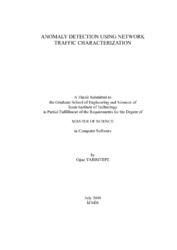Please use this identifier to cite or link to this item:
https://hdl.handle.net/11147/3459Full metadata record
| DC Field | Value | Language |
|---|---|---|
| dc.contributor.advisor | Tuğlular, Tuğkan | - |
| dc.contributor.author | Yarımtepe, Oğuz | - |
| dc.date.accessioned | 2014-07-22T13:51:34Z | |
| dc.date.available | 2014-07-22T13:51:34Z | |
| dc.date.issued | 2009 | - |
| dc.identifier.uri | http://hdl.handle.net/11147/3459 | - |
| dc.description | Thesis (Master)--Izmir Institute of Technology, Computer Engineering, Izmir, 2009 | en_US |
| dc.description | Includes bibliographical references (leaves: 63-66) | en_US |
| dc.description | Text in English Abstract: Turkish and English | en_US |
| dc.description | ix, 80 leaves | en_US |
| dc.description.abstract | Detecting suspicious traffic and anomaly sources are a general tendency about approaching the traffic analyzing. Since the necessity of detecting anomalies, different approaches are developed with their software candidates. Either event based or signature based anomaly detection mechanism can be applied to analyze network traffic. Signature based approaches require the detected signatures of the past anomalies though event based approaches propose a more flexible approach that is defining application level abnormal anomalies is possible. Both approach focus on the implementing and defining abnormal traffic. The problem about anomaly is that there is not a common definition of anomaly for all protocols or malicious attacks. In this thesis it is aimed to define the non-malicious traffic and extract it, so that the rest is marked as suspicious traffic for further traffic. To achieve this approach, a method and its software application to identify IP sessions, based on statistical metrics of the packet flows are presented. An adaptive network flow knowledge-base is derived. The knowledge-base is constructed using calculated flows attributes. A method to define known traffic is displayed by using the derived flow attributes. By using the attributes, analyzed flow is categorized as a known application level protocol. It is also explained a mathematical model to analyze the undefined traffic to display network traffic anomalies. The mathematical model is based on principle component analysis which is applied on the origindestination pair flows. By using metric based traffic characterization and principle component analysis it is observed that network traffic can be analyzed and some anomalies can be detected. | en_US |
| dc.language.iso | en | en_US |
| dc.publisher | Izmir Institute of Technology | en_US |
| dc.publisher | Izmir Institute of Technology | en_US |
| dc.rights | info:eu-repo/semantics/openAccess | en_US |
| dc.subject.lcc | QA76.9.A25 .Y28 2009 | en |
| dc.subject.lcsh | Computer security | en |
| dc.subject.lcsh | Anomaly detection (Computer security) | en |
| dc.title | Anomaly Detection Using Network Traffic Characterization | en_US |
| dc.type | Master Thesis | en_US |
| dc.authorid | TR144185 | - |
| dc.institutionauthor | Yarımtepe, Oğuz | - |
| dc.department | Thesis (Master)--İzmir Institute of Technology, Computer Engineering | en_US |
| dc.relation.publicationcategory | Tez | en_US |
| dc.identifier.wosquality | N/A | - |
| dc.identifier.scopusquality | N/A | - |
| item.openairecristype | http://purl.org/coar/resource_type/c_18cf | - |
| item.languageiso639-1 | en | - |
| item.openairetype | Master Thesis | - |
| item.grantfulltext | open | - |
| item.fulltext | With Fulltext | - |
| item.cerifentitytype | Publications | - |
| Appears in Collections: | Master Degree / Yüksek Lisans Tezleri | |
Files in This Item:
| File | Description | Size | Format | |
|---|---|---|---|---|
| T000819.pdf | MasterThesis | 992.83 kB | Adobe PDF |  View/Open |
CORE Recommender
Page view(s)
268
checked on Mar 31, 2025
Download(s)
690
checked on Mar 31, 2025
Google ScholarTM
Check
Items in GCRIS Repository are protected by copyright, with all rights reserved, unless otherwise indicated.